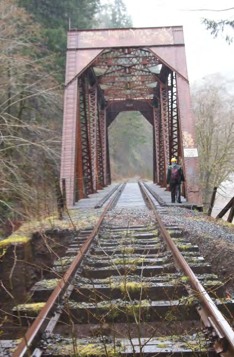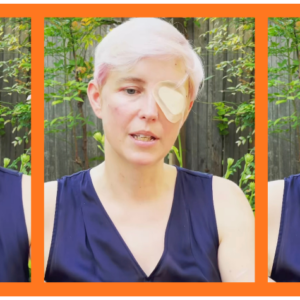
Forest will someday be a biking and
walking path.
(Photo: Salmonberry Corridor
Preliminary Feasibility Report)
The third annual Regional Trails Fair will be held tomorrow at Metro headquarters from 1:00 to 3:30 pm. The event will bring together more than 35 trail advocacy organizations and government agencies to share the latest updates on trail projects throughout the Portland region. And there’s a lot to talk about!
Did you know there’s a major effort underway (with support from Oregon Parks & Recreation) to create a new rail-trail that would connect the town of Banks to Tillamook on the Oregon Coast? The Salmonberry Trail, which won a $100,000 planning grant from Cycle Oregon last year, would allow riders to travel 85 miles through the Tillamook Forest without ever seeing a car.
There’s also the recently renamed Ice Age Tonquin Trail which has already been partially built and has ambitious plans to connect Tualatin to Wilsonville via a 22-mile path.
As for more urban trail projects, the North Portland Greenway is in active planning and construction stages and the City of Portland is in line for a state grant that would build the first section of the Sullivan’s Gulch Trail.
Those are just a few of the dozens of trail projects in various stages of completion throughout the region. With Metro’s Intertwine continuing to gain steam and a new trail funding measure being discussed in the legislature, there has never been more momentum for these projects.
Also scheduled during the event is a presentation from Lake McTighe on how the Regional Active Transportation Plan is creating priority walking and biking routes.
-
Regional Trails Fair
May 8th from 1:00 – 3:30 pm
Metro Headquarters (600 NE Grand Ave)
Event website for more information






Thanks for reading.
BikePortland has served this community with independent community journalism since 2005. We rely on subscriptions from readers like you to survive. Your financial support is vital in keeping this valuable resource alive and well.
Please subscribe today to strengthen and expand our work.
The 85 mile, car-free, trip to the Oregon Coast would be a boon for the local economy. Can you imagine what that would do for the tourism industry???
Can I build the brewpub at mile 45?
Seriously, I’m a huge fan of the rails-to-trails program. A car-free way to bike through Oregon’s best regions would be an amazing lift to local economies and the state’s tourism. The Yamhalem rail-to-trail project from Gaston to McMinnville will be amazing when/if it ever gets built!
Oh man. An 85 mile car free route through the Tillamook forest to the coast!? That would be the best thing ever. I wonder if they could/would set up a primitive camp site on the way. I’m too old and fat to do 100 miles in a day.
Is this really going to happen or is it just a fantasy? Even if it did happen, I wonder if it would even be completed in my life time.
-Cota
Scanned over the Salmonberry route, and it looks amazing. There are a few sections that have been wiped out by landslides or otherwise lost to the forest, but 99% of it looks like it’s intact. All the bridges are there too. In my fantasy world, I see an uninterrupted ribbon of asphalt for skinny tires, and a parallel singletrack for anybody who wants an epic trip by hiking boot or mountain bike. Add a couple campgrounds, maybe an inn in Timber, and the locals could print money selling bananas and chamois cream to tired tourists.
Is there any history of Rail-to-Trail conversions being reclaimed by rail uses thereby removing an existing trail?
Seems that if our society gets a brain wave we’d rehab all the old freight rails and tax encentivize big truck freight using companies to relocate or establish sites that use rail freight over OTR truck freight.
The reclaim by RR is a concern of mine as well. If a pacific port were able to get coal by rail over that alignment is would negatively impact the character of a beautiful piece of desolate country.
No port that can handle that type of load exists on the Oregon coast as the big ships come down the Columbia to the Port of Portland. The main industries in Tillamook are cows, cheese, and tourism.
The Port of Tillamook Railroad probably isn’t going to be rehabbed, as they don’t get a lot of freight. All the trees were cut down 50 years ago. The Coast Range’s environment is brutal on infrastructure, and there are a lot of landslides, like up north of Seattle. Also, the railroads were built right down next to the mountain rivers, which are devastating when the flood. Modern geo-engineering helps to prevent washouts and flood damage, but the old railroad is really prone to those effects. I’d be curious to see if a trails route can be kept open without it being wiped out like the railroad.
I have similar concerns. I think the trail offers more flexiblity. It can zig zag around obstacles, narrow in sections, and include steeper grades to climb up and around obstacles. The Banks Vernonia trail is a good example. There are a few sections where it deviates from the old rail bed to avoid obstacles.
I’ve poked around either end of the Salmonberry line and can tell you that the country is absolutely gorgeous and remote. If built it would be an incredibly rare gem!
Here is a rad article about biking the Salmonberry Corridor 20 years ago!
http://articles.latimes.com/1995-11-05/local/me-65012_1_bikes-rail-bicycles/2
And I can’t find it now, but I’ve read a neat trip report of a couple folks fatbiking it since it closed in 08.
“The 85 mile, car-free, trip to the Oregon Coast would be a boon for the local economy. Can you imagine what that would do for the tourism industry???”
Agreed. Once some of the projects planned for improving bike access in the Gorge get done, along with the Salmonberry, the (even longer term) proposal for rail-trail to Astoria, a better connection to the rest of the Willamette Valley and the Springwater-Cazadero gap, the ongoing OPRD work on the Scenic Bikeway network, along with better knowledge of and connections to the Banks-Vernonia-Crown Zellerbach loop, bike tourism in our region is poised to EXPLODE.
I’ve hiked the Salmonberry Rail lines several times it is already spectacular. With its remoteness, clear water, access to the pacific, tall wooden trestles, and multiple tunnels, it could easily be one of the worlds best multi-use trails. It would be written up in many travel publishing’s. (It is also possible in the future to connect the trail all the way to downtown Portland if the remaining rail from Banks to Portland is abandoned. 100+ miles car-free)
There is already a nice place to stay along Nehalem River Road at the confluence of the Nehalem River and the Salmonberry River(www.salmonberry.com). They are probably ecstatic about the idea of hikers/bikers flowing past their “estate” in the future.
You can hike miles upriver along the tracks from their location and come back to a wood-fired hot tub and a comfy lodge.
A group called the Wild Salmon Center did a report on this area in 2008, following the devastation of the existing rail line.
http://www.wildsalmoncenter.org/pdf/salmonberry_white_paper_2008.pdf
I agree with Q Tzal that we as a society should guard our rail ROWs carefully, as they represent an investment in a level path that could in some cases turn out to be useful in the future, for freight and/or passenger service. That said, some say that these were marginally built, even at the time, and would not be worth reusing for rail because of the propensity to slides, etc. (Which in some cases is why they failed as railroad companies)
Every truck trip that can be converted to rail gets trucks off the roads (including sometimes the in-town street system), and reduces fuel usage. In the future, we might see fit to even electrify railroads on the west coast, allowing more flexibility in fuel source.
It does seem that the rail connection to Astoria should be preserved, for the industries there as well as for the return of rail passenger travel (with provision for bikes on board)!